Innovations in urban food systems

By 2050, two-thirds of the world’s population will likely live in cities.
The challenge is to feed these rapidly growing urban populations in a way that is sustainable, healthy, affordable and environmentally sound.
FAO Investment Days 2017 explored innovations in urban food systems, from the latest in city farming and waste reduction to food policy and public-private partnerships.
“All of the different aspects of urban food systems – access to healthy, affordable food, food safety, waste disposal, transportation, youth employment – are interlinked,” said Cora Dankers, an FAO agribusiness officer.
“It’s encouraging to see more cities working together across sectors – the health department talking to the agriculture department talking to the infrastructure department –which didn’t happen much before. And policy-makers are paying more attention to the rural-urban linkages.”
City farming
One innovator is the Nigerian company Fresh Direct. Based in Abuja, it uses stackable shipping containers to grow fresh organic produce for the city’s local markets.
Relying on hydroponics and vertical farming, each container can accommodate 3,000 plants and be stacked up to five stories high – consuming less water and land.
Angel Adelaja, CEO of Fresh Direct, explained how the company aims to bring agriculture, advanced technology and communities together to grow holistically and to create job opportunities for urban youth.

“We provide young people with the land, power, inputs and markets, such as supermarkets, restaurants, hotels,” she said. “Most have never farmed before, but they are learning everything, from boosting yields to packaging and delivery.”
The company, she added, is focused on displacing the import market rather than competing with rural farmers.
“Farmers in rural areas can continue growing staples like cassava and potatoes. We are growing leafy green vegetables – lettuces, kale, bok choy – normally imported from Germany and difficult to find in Nigeria,” she said.
Minimising waste
Much of urban consumer waste is related to food, from food packaging to organic refuse.
Novamont is an Italian company leading in the research and production of biochemical and biodegradable plastics for food packaging, carrier bags, tableware and other items.
Partnering with multiple stakeholders, including research universities, it adopts a system-based approach to find solutions for disposing and reusing waste more efficiently.
One project is with the city of Turin and its Porta Palazzo, one of the largest fresh food markets in Europe. There they have begun separating foods that are no longer edible from foods that still are.
The non-edibles are delivered to organic waste treatment facilities, while the edibles are being transformed into healthy and safe food products, like soups, to be sold onsite and throughout the city.
Inter-sectoral collaboration
In Kenya, until recently, the central government was responsible for implementing the national agriculture policy.
But today that decision-making rests with the counties, one of which is the city of Nairobi.
Nairobi county has ten different departments, explained Bernard Mugenyo, Nairobi County Executive Committee member for Agriculture, Livestock Development and Fisheries.
“As the agricultural department, we could handle the production side very well, but when it came to regulating urban and peri-urban agriculture in Nairobi, we found we needed to involve all of the other departments,” he said.
The city is now finalizing a food systems strategy, involving multiple stakeholders, also from academia and the private sector, as part of an FAO project on urban food systems in Nairobi, Dhaka and Lima.
Integrated and inclusive approach
Increasingly, cities are innovating and taking the lead in developing sustainable food systems. Many are working through international networks such as the Milan Urban Food Policy Pact.
While their entry points into urban food policy are different, having an integrated and inclusive approach is vital, said Corinna Hawkes, Director of the Centre for Food Policy at City University, London.
“Policy-makers have to think about problems throughout the entire system and supply chain – how to get enough food into the city, where it’s to be sold, what types of health problems could arise from an unhealthy diet, whether people are food secure, if the food is safe, the relationship with the rural markets, the impact of climate change. The list goes on,” she said.

Understanding the extent to which urban food policies and initiatives are having a positive impact on nutrition and other outcomes, however, is a challenge as there is little available impact evaluation.
“A lot of work is being done now to develop robust indicators in this area, which will help inform investments in urban food systems,” Dankers said.
“We’re seeing a lot of interest at the municipal level to work across departments and invest in this type of data collection, so that’s a big opportunity.”
When discussing better access to sustainable, safe and nutritious food, the urban perspective offers incentives for innovative inter-sectoral collaboration and stakeholder partnerships. It also creates novel investment opportunities along the entire value chain.
This article is part of a series to share the latest thinking and learning on innovations in agriculture from FAO Investment Days 2017.

